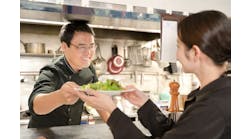I was talking to some retail executives recently and the conversation became focused on competition. It was not surprising that everyone was very concerned about the big guys that were taking their customers and their sales. What surprised me about the conversation was they seemed rather uninterested in the little guys that were taking their customers and sales.
Now I understand that when someone is beating you over the head with a bat, you may be more interested in the guy beating you than the guy standing in line waiting for his turn. On the other hand, I believe that a prudent food retailer should recognize that 100 small competitors can be just as troublesome as one large competitor.
So the discussion focused on who are all these small competitors. First I reminded the executives that most of the big competitors were once small competitors who were ignored. I also reminded them that the food industry, and particularly the Food Marketing Institute, refused to recognize Walmart as a competitive grocery store. When they finally included Walmart in the list of food retail chains, it was No. 1 on the list.
The issue for food processors is: To what extent do you support and develop policies and procedures that make it possible for your company to do business with the small market segments that someday may become the largest players in the market? So the question becomes which of the small guys could become big guys sometime in the future?
Let's begin by looking at chain pharmacies. There was a time when they were content selling candy and the ilk. However once they recognized that people made more visits to stores for food than for health and beauty products, food became a more important part of the store's product assortment. Today, many pharmacies have signs in front of the store proclaiming it as a “food market.”
The same thing happened at dollar stores. Grocery is now one of their biggest categories.
Another obvious nontraditional channel for food is the convenience store. They are improving their image and selling more food every year. In the cases where they also sell gasoline, many have taken advantage of the 4 or 5 minutes consumers have with nothing to do while they're filling the gas tank by running commercials on a video screen atop the pump that advertise food products.
Traditional grocery is also losing out to many of the new subscription services, such as Dollar Shave Club, Birchbox, Soupergirl etc. Every week or month an order is shipped to the house automatically. No need to think about it, and no worry about running out. More importantly, no visits to stores.
Some childcare centers such as Little Leprechaun are now preparing meals for the family, so busy mothers or fathers can make one stop, picking up kids and dinner at the same time. They publish weekly menus and make it clear that any of these meals can be purchased for takeout. I have repeatedly asked parents if they would be willing to pay a premium for such a service, and there is always an overwhelming yes.
Have you been in Staples or Office Depot lately? Have you seen the amount of food that's available for sale? They basically have solved a major problem for office administrators, who once had to go to the grocery store and purchase various office food supplies such as coffee, sugar, creamer, candy, napkins etc. Today, one can pick up the phone and order paper and pencils plus all the food needed for the office.
One other segment often ignored by traditional food processors is the TV home shopping shows such as HSN and QVC. Although usually thought of as selling makeup, clothing and jewelry, these television shows sell a lot of food. For example HSN has 55 meat and poultry items for sale, nine seafood items, and 33 entrée items. Not only do consumers not have to visit the store, they don't have to get out of their chairs.
A huge market missed by many food processors is the college market or college bookstore market. The students are eating and drinking machines (not necessarily in that order) that seem to get little attention from traditional food marketers, both retailers and processors. I know of one major mass merchant that is examining the concept of a specific store in very close proximity to college campuses selling products that college students desire.
Quite frankly I could likely fill the entire edition of Food Processing magazine with examples of emerging food channels that seem to be neglected by traditional food marketers. I have discussed this in the past and most of the executives say that when they become big enough they will play in that market. I guess I can't object to that strategy other than to say if you become a partner when the channel is embryonic instead of waiting, you could own that channel.
Making an explicit decision not to get involved in emerging channels may be very reasonable. What is not reasonable is to fail to monitor and understand what's happening outside the world of the big three channels of distribution (supermarkets, mass merchants and club stores). It is one thing to make a decision based on full knowledge, it's a very different thing to be unaware of what's happening around you, and to think that you are acting professionally.

